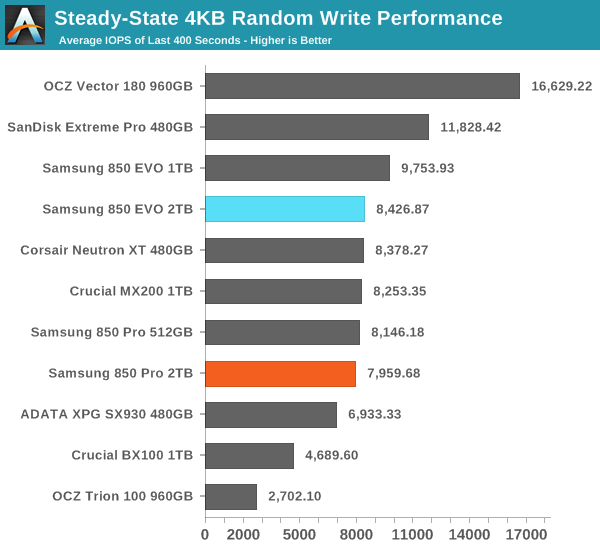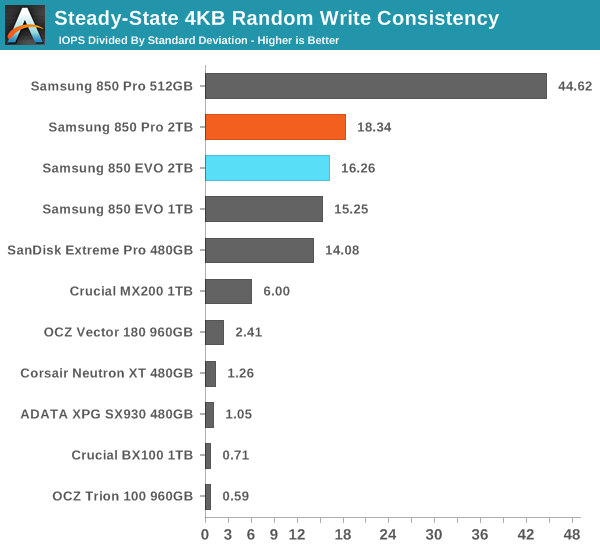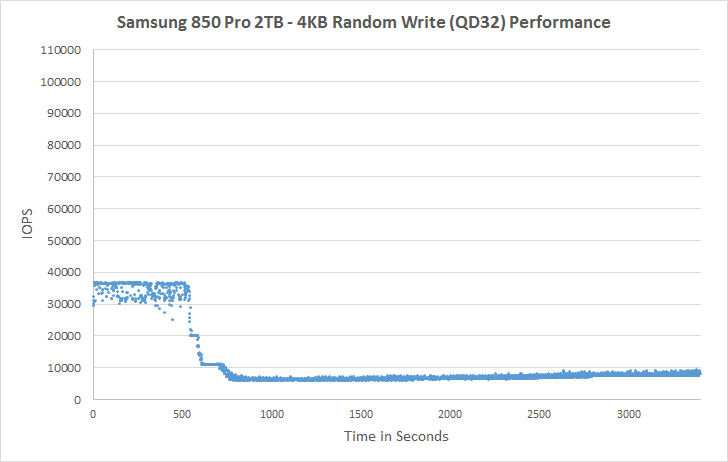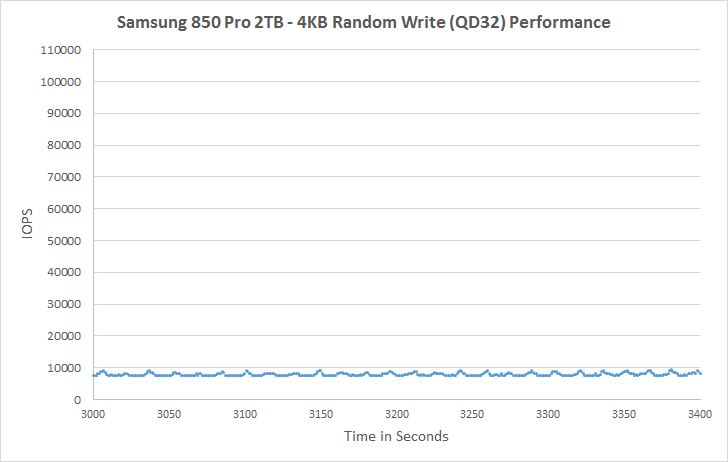The 2TB Samsung 850 Pro & EVO SSD Review
by Kristian Vättö on July 23, 2015 10:00 AM ESTPerformance Consistency
We've been looking at performance consistency since the Intel SSD DC S3700 review in late 2012 and it has become one of the cornerstones of our SSD reviews. Back in the days many SSD vendors were only focusing on high peak performance, which unfortunately came at the cost of sustained performance. In other words, the drives would push high IOPS in certain synthetic scenarios to provide nice marketing numbers, but as soon as you pushed the drive for more than a few minutes you could easily run into hiccups caused by poor performance consistency.
Once we started exploring IO consistency, nearly all SSD manufacturers made a move to improve consistency and for the 2015 suite, I haven't made any significant changes to the methodology we use to test IO consistency. The biggest change is the move from VDBench to Iometer 1.1.0 as the benchmarking software and I've also extended the test from 2000 seconds to a full hour to ensure that all drives hit steady-state during the test.
For better readability, I now provide bar graphs with the first one being an average IOPS of the last 400 seconds and the second graph displaying the IOPS divided by standard deviation during the same period. Average IOPS provides a quick look into overall performance, but it can easily hide bad consistency, so looking at standard deviation is necessary for a complete look into consistency.
I'm still providing the same scatter graphs too, of course. However, I decided to dump the logarithmic graphs and go linear-only since logarithmic graphs aren't as accurate and can be hard to interpret for those who aren't familiar with them. I provide two graphs: one that includes the whole duration of the test and another that focuses on the last 400 seconds of the test to get a better scope into steady-state performance. These results are for all drives 240GB and up.

In steady-state 4KB random write performance the EVO is actually slightly faster than the Pro, but given that the EVO employs more over-provisioning (12% vs 7%), it's not out of the ordinary. The 2TB EVO performs slightly lower than the 1TB model, so it seems that despite the upgraded DRAM controller the controller may not be ideal for more than 1TB of NAND (internal SRAM caches and the like are the same as in the MEX controller). Nevertheless, the difference isn't substantial and in any case the Pro and EVO both boast excellent steady-state performance.

Both 2TB drives also have great consistency, although the 2TB Pro can't challenge the 512GB Pro that clearly leads the consistency graph. Given the same amount of raw processing power, managing less NAND is obviously easier because the more NAND there is, the more garbage collection calculations the controller has to process, which results in increased variation in performance.
 |
|||||||||
| Default | |||||||||
| 25% Over-Provisioning | |||||||||
The behavior in steady-state is similar to other 850 Pro and EVO drives, which is hardly surprising given the underlying firmware similarities. One area to note, though, is the increased performance variation with additional over-provisioning (OP), whereas especially the 512GB Pro presents very consistent performance with 25% OP. In any case, performance with additional OP is class-leading in both Pro and EVO.
 |
|||||||||
| Default | |||||||||
| 25% Over-Provisioning | |||||||||










66 Comments
View All Comments
twizzlebizzle22 - Thursday, July 23, 2015 - link
Damn, we are in the future here. Roll in the day when my media storage drives are all SSD.Interesting as to why they managed to double the drive durability from 150TB to 300TB. That's pretty substantial.
joex4444 - Thursday, July 23, 2015 - link
Durability is the amount of data that can be written to the drive Samsung is guaranteeing can be written to it during its life. It's just related to the number of times a chip can be completely rewritten. If you double the capacity, you double the number of chips, and therefore you double the durability.lilmoe - Thursday, July 23, 2015 - link
Sure, but Samsung is also setting the older 512GB and 1TB at 300TB endurance rating up from 150TB previously, which is nice.SleepyFE - Friday, July 24, 2015 - link
If i'm not mistaken that was a marketing move. The EVO was sold as 150 so that people who needed more would buy PRO. There was a super punishing SSD test half a year back (a bit less maybe) where they tested how much the drives can take before the cells give up and even the EVO held out beyond 300. So they didn't really manage to improve anything, they just decided to extend their guarantee.leexgx - Saturday, July 25, 2015 - link
EVO not as reliable as the Pro (TLC EVO vs MLC PRO,) the pro drive never failed with bad data it silently failed at 2PBthe endurance is for warranty before where they have found errors have cropped up, the PRO drive use MLC so is reliably less error prone (as in they handle any minor errors better then TLC) then EVO under extreme loads (drives might look the same but the flash is not)
leexgx - Thursday, July 23, 2015 - link
sorry if this is been asked before, is the 25% OP been done via the ATA command that allows you to set amount of useable space or are you just partitioning it (both after a Secure erase)Samus - Thursday, July 23, 2015 - link
You don't even need to go that far. The Samsung Magician toolbox allows you to set a RAW OP "partition"leexgx - Thursday, July 23, 2015 - link
i looked online i guess it worked as i thought it would, you can use ATA LBA limit command to hard limit the OP space or just make the partition say 20GB less then the size of the SSD (or what ever size you want) this is assuming its a fresh drive or secured erased state, but the thing is TRIM does the same thing any way (assuming you don't fill the drive so it runs out of space) if you cant use TRIM then you need to set higher OP space (recommended any way)TEAMSWITCHER - Thursday, July 23, 2015 - link
Not quite yet.... I've been limping along with a pair of 840 EVO's waiting for this Samsung 3D flash in an m.2 form factor with a PCIe x4 with NVMe controller. All of this technology is mature, and my motherboard has the m.2 slot and BIOS support for NVMe, but Samsung hasn't put it all together yet. I'm not shelling out any more money for SATA III SSDs when I feel that any time now...Samsung will introduce the product I've been hoping for. Am I foolish to think this product in imminent?Impulses - Thursday, July 23, 2015 - link
Hmm, I'm not sure anyone could really say... It's plausible they might skip retail availability of the SM951 AHCI & NVMe versions altogether and release something with 3D NAND this year, but I think they haven't released the former to begin with because the demand just isn't there outside of OEMs.Might change after Skylake, might not, I doubt the average enthusiast is chomping at the bit to pay $1/GB for a drive but I dunno how much cheaper the SM951 would be in volume. I'm just aiming for a 256GB SM951 post-Skylake, for the OS, paired with 850 EVOs for storage.